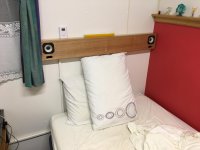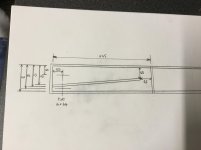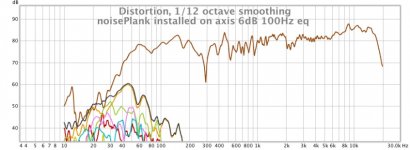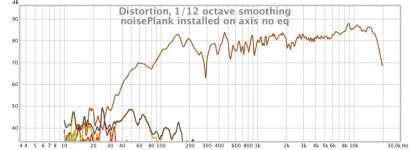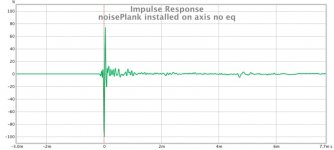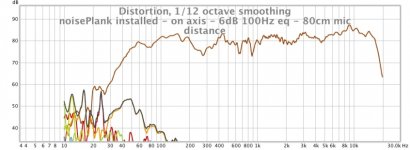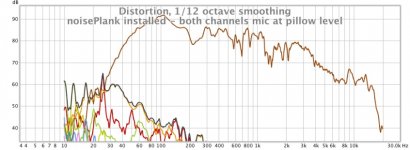Hey Graham, you were dead right about the baffle step compensation not being needed when mounted on the wall. In my room with the speakers mounted to the wall there was way too much bass. Measurement confirmed I had about an 8dB high lump from 50-100Hz. Removing the equaliser fixed it quite nicely. I'm running with an 80Hz, 6dB step now via the minidsp and that's pretty much on the money.
The new speakers are wonderful compared to the old cubes. Just perfect for my room. Oodles of bass and way more volume than I can use.
The new speakers are wonderful compared to the old cubes. Just perfect for my room. Oodles of bass and way more volume than I can use.
Attachments
You have more than a back wall, a side wall as well so should have lots of extra bass gain. Looks nice as a bed room sound bar.
Are you willing to share the size of the vent/opening and measurements on where to place the TC9? I'm also not sure of the length of the divider- 50cm? And the last question- how far is the divider from the top wall at it's origin and terminus?
You're work is inspiring. My daughter's family has a run of the mill soundbar. I might give this some thought to offer as a replacement and improvement.
Thanks.
Mike
You're work is inspiring. My daughter's family has a run of the mill soundbar. I might give this some thought to offer as a replacement and improvement.
Thanks.
Mike
That's very cool Suzy. It's always good when practice agrees with theory! And they look fantastic there, with the timber that matches your mantlepiece.
Will you be taking some measurements? Most meaningful would be with the left driver disabled and the mic on axis with the right driver, and a suitable gate time to try to eliminate the bounce off the wall (probably not feasible now I think about it).
And now that I think about it some more, an on-axis measurement is in this case almost irrelevant because of your unusual listening position below and beside the enclosure. But it would be fun to do, and to see how this concept performs as a wall mounted TV speaker for instance.
Graham.
Will you be taking some measurements? Most meaningful would be with the left driver disabled and the mic on axis with the right driver, and a suitable gate time to try to eliminate the bounce off the wall (probably not feasible now I think about it).
And now that I think about it some more, an on-axis measurement is in this case almost irrelevant because of your unusual listening position below and beside the enclosure. But it would be fun to do, and to see how this concept performs as a wall mounted TV speaker for instance.
Graham.
Hi guys,
Attached plots and dodgy drawing. Plots are done with -100, +400ms window. I think I'm seeing the other side of the room in the impulse response, but there's a _lot_ of absorbing surfaces and stuff in this tiny room so it's well down. It's in line with the driver away from the wall. At my usual listening spot the treble suffers a lot.
The hole at 300Hz is perplexing. These was a shallow dip around here previously but nothing like this. I wonder if I've got an air leak?
Attached plots and dodgy drawing. Plots are done with -100, +400ms window. I think I'm seeing the other side of the room in the impulse response, but there's a _lot_ of absorbing surfaces and stuff in this tiny room so it's well down. It's in line with the driver away from the wall. At my usual listening spot the treble suffers a lot.
The hole at 300Hz is perplexing. These was a shallow dip around here previously but nothing like this. I wonder if I've got an air leak?
Attachments
Last edited:
Hi guys,
Attached plots and dodgy drawing. Plots are done with -100, +400ms window. I think I'm seeing the other side of the room in the impulse response, but there's a _lot_ of absorbing surfaces and stuff in this tiny room so it's well down. It's in line with the driver away from the wall. At my usual listening spot the treble suffers a lot.
The hole at 300Hz is perplexing. These was a shallow dip around here previously but nothing like this. I wonder if I've got an air leak?
Thanks Suzy!
I think I've got a candidate for the 300Hz hole. The side wall is 1150mm away from this driver, 1 wavelength at 300Hz.
Nice project Suzy! Slightly off topic, where do you source your timber? And the ply you use for your 'other hobby'?
I think I've got a candidate for the 300Hz hole. The side wall is 1150mm away from this driver, 1 wavelength at 300Hz.
Eigenmodes are 1/2 WL reflections, so a 300 Hz notch would be around half that distance, so at a glance it looks like it's in the speaker.
GM
Last edited:
Looks like it was just mic position. I moved the mic in a little and the hole vanished. Go figure. Also see the plot for head-on-pillow, which is rather bass-heavy.
Stuey, I just buy timber from Bunnings. It's not a very good selection. They stopped selling tassie oak about 12 months ago, and I bagged a pile on clearance.
Stuey, I just buy timber from Bunnings. It's not a very good selection. They stopped selling tassie oak about 12 months ago, and I bagged a pile on clearance.
Attachments
Thanks Suzy. I actually noted they'd stopped selling it as I went there specifically to have a look for it about two months ago, hence the question.
I'm jealous of the northern hemisphere members and their apparent choice of fine plywoods!
I'm jealous of the northern hemisphere members and their apparent choice of fine plywoods!
Looks like it was just mic position. I moved the mic in a little and the hole vanished. Go figure. Also see the plot for head-on-pillow, which is rather bass-heavy.
Hmm, main dip is still there; is the cab tuned to around 60-65 Hz?
GM
That 290Hz dip corresponds to a 59cm half-wave reflection cancellation somewhere. Might be a nearby wall or even the distance from driver to the 180deg hairpin turn if there is not enough felt on the corner. Usually it is the floor bounce if your mic is farther than 50cm away. Try turning on Frequency Dependent Window (FDW) gating in REW and choose 6 cycles - that should just be the native speaker and not from reflections nearby.
SL/S0 is 0.2, and line length is ~1m (40"), giving a 1/4 wave at 60Hz according to the tables. I'm not sure how valid the tables are in this case as I didn't calculate SL according to MJKs math, being constrained by wanting to keep the plank as flush to the wall as I'm able.
I'd never thought of adding felt at the turn. Thanks for that suggestion, I'll certainly give that a go on the next one. In prototyping, I simply added stuffing until the dip wasn't objectionable.
I'd never thought of adding felt at the turn. Thanks for that suggestion, I'll certainly give that a go on the next one. In prototyping, I simply added stuffing until the dip wasn't objectionable.
- Status
- Not open for further replies.
- Home
- Loudspeakers
- Full Range
- noisePlank - a simple folded TL with TG9FD10
